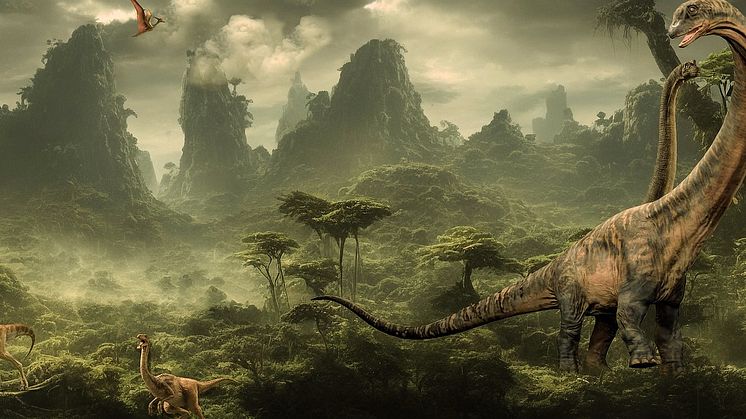
Pressmeddelande -
Fascinating Insights into the World of Dinosaurs: New Discoveries and Scientific Findings
Since their discovery, dinosaurs have captivated humanity. The idea of prehistoric giants continues to fuel the imagination, but scientific research increasingly reveals a more complex and fascinating picture of these creatures than ever before. New technologies, fossil discoveries, and interdisciplinary studies continuously expand our knowledge. Here are some of the most exciting current topics in dinosaur research.
A Burst of Color Instead of Gray: New Insights into Dinosaur Color Patterns
For a long time, it was believed that dinosaurs had gray or brown skin, similar to today's reptiles. However, this assumption has been disproved by new scientific methods. The analysis of melanosomes, small pigment carriers preserved in fossil remains, allows researchers to deduce the colors and patterns of dinosaurs.
A remarkable example is the dinosaur Anchiornis, whose feather pattern has been reconstructed. It had black-and-white feathers and a striking red crest. This discovery shows that dinosaurs likely had a much greater variety of colors and patterns than previously thought. Colorful patterns may have played a role in camouflage, mate selection, or territorial marking. These new insights shift our perception of dinosaurs from dull creatures to vividly colored beings.
Complex Social Structures in Dinosaurs: More Than Just Loners
New fossil discoveries suggest that many dinosaur species exhibited complex social behavior. In various excavation sites, skeletons of dinosaurs have been found arranged in groups, indicating that these animals lived in herds. Additionally, fossil nests have been found, showing that some species actively cared for their offspring.
A fascinating example of this is Maiasaura, whose name means "good mother lizard." Fossil evidence suggests that these dinosaurs built their nests in colonies and cared for their young over an extended period. There are also indications of complex communication methods, such as vocalizations or visual signals. This suggests that dinosaurs may have developed social bonds and group dynamics previously attributed mainly to mammals.
New Dinosaur Species: The Diversity Keeps Growing
Every year, paleontologists make new discoveries that expand our understanding of the dinosaur world. From small, bird-like species to gigantic carnivores, the diversity of dinosaur species seems endless. Particularly surprising are discoveries of unusual species that raise new questions about their anatomy and way of life.
One example is the recently discovered Ulughbegsaurus uzbekistanensis, a massive theropod from Central Asia that may have been a top predator of its time. Such discoveries raise new questions about the geographical distribution and evolutionary development of dinosaurs. The discovery of tiny species like Pulanesaura also shows that dinosaurs existed in all shapes and sizes and that their habitats were more varied than previously thought.
Fossil Sites as Time Capsules: The Jurassic Highway in Oxfordshire
One of the most significant discoveries in recent years is the so-called "Jurassic Highway" in Oxfordshire, England. In this prehistoric site, fossils of dinosaurs, plants, and other organisms have been found, painting a detailed picture of the ancient environment. The Jurassic Highway is considered a kind of time capsule that provides insights into life around 168 million years ago.
Particularly noteworthy is the discovery of well-preserved dinosaur tracks, indicating that various species used this prehistoric path. The study of such sites provides crucial information about the movement patterns, behavior, and interactions of dinosaurs.
Technological Advances Revolutionize Dinosaur Research
In addition to new fossil discoveries, technological innovations play a crucial role in modern paleontology. Through the use of 3D scans and CT scans, researchers can digitally reconstruct fossil remains and gain detailed insights into the anatomy and behavior of dinosaurs. Artificial intelligence is used to simulate movement sequences and gain new insights into how these animals moved.
Moreover, genetic analyses of bird DNA provide clues about the evolutionary connection between dinosaurs and modern birds. These findings show that many traits observed in birds, such as feathers, lung structures, and a high metabolic rate, were already present in dinosaurs.
Dinosaur research is currently experiencing a true renaissance. New discoveries and technological advances expand our knowledge of the lifestyle, behavior, and diversity of these prehistoric creatures. From colorful feathers to complex social structures, to new species and significant fossil sites, every new finding contributes to completing the fascinating mosaic of the dinosaur world. Research shows us that dinosaurs were far more than the fearsome creatures we know from movies: they were highly developed, diverse, and fascinating beings that shaped our Earth for millions of years.